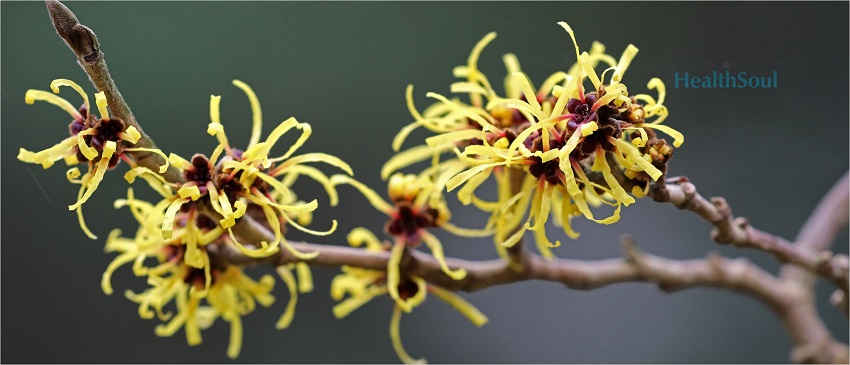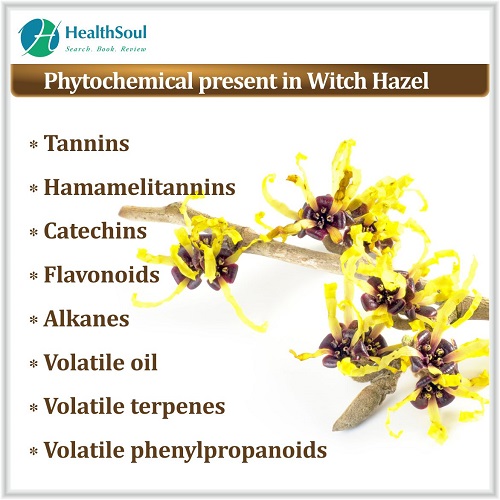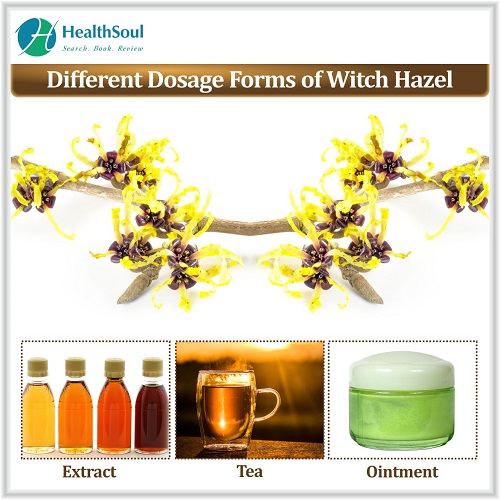Health benefits of Witch Hazel

Witch hazel, botanically named as Hamamelis virginiana, which belongs to a family Hamadelidaceae. The Atlantic coast of North America is the native place of this plant. It is widely found in Florida, Nova Scotia, Texas. Depending upon the geographical location, the plant and leave structure little varies. The plant may become under a tall shrub or small tree with a height up to 4.6 m tall. The branches of the plant arise from the base. The length of the leaves varies from 1cm to 5 cm long and follow alternate or stipulate arrangement with short petioles. Golden-yellow colored, thread-like flowers and grown as in axillary clusters. The fruit of this is a two-beaked, two-celled, woody capsule. Each cell contains a single black seed. The unusual feature of this plant is both flowers and fruit appear at the same time.
European pharmacopeia has specified the quality specification of Witch hazel. Whereas German Drug Codex has also mentioned the drug quality of Witch hazel bark, Witch hazel leaves fluid extract and Witch hazel bark fluid extract.
This plant parts are used in traditional medicinal practice. Following are some traditional medicinal use of Witch hazel:
- Eye irritation may occur due to smoky atmospheres, prolong swimming in the sea or swimming pool can be treated with Witch hazel leaf. External application of Witch hazel eye formulation provides temporary relief from eye irritation or discomfort.
- Traditional practitioners recommended Witch hazel leaf to treat hemorrhoids symptoms, the sensation of heavy legs. Leaves and bark usually used for preparing formulation to treat hemorrhoids.
- A throat infection can also be treated with Witch hazel containing gargle due to its anti-inflammatory effect.
- Witch hazel bark is recommended for external application to treat small wounds, skin injuries and bruises, atopic dermatitis, skin inflammatory condition, mucous membrane inflammation, hemorrhoids, and varicose veins.
- Oral intake of witch hazel bark preparation is recommended to treat diarrhea, hemorrhoids and mucous colitis.
- Traditionally this herbal ingredient is used for cosmetic and skincare purposes to improve skin roughness.
- In folk medicine, Witch hazel formulation is recommended to treat menorrhagia and dysmenorrhoea due to its hemostatic property.
- External application of Witch hazel leaf can treat bruises, sprains, neurodermatitis atopica.
Phytochemicals and their mechanism of action
The active phytochemicals include tannins, primarily hamamelitannins, and catechins. The concentration of flavonoids is more in leaves than the roots. Witch hazel leaves and bark contain tannins, alkanes, volatile oil, volatile terpenes. Volatile phenylpropanoids are only present in the bark.

Different dosage forms
Hamamelitannins and proanthocyanidins are two tannins of witch hazel bark which have a strong anti-inflammatory effect. An in-vitro research study reported that these phytochemicals have a potent inhibitory effect on 5-lipoxygenase activity and platelet-activating factor. These herbal constituents can reduce the production of leukotriene B4, and proanthocyanidins. An animal research study reported that topical application of witch hazel bark confirmed the anti-inflammatory effect.
There are different witch hazel herbal formulations are formulated from leaves and bark.
- For external application leaves, infusion preparation is formulated by cutting witch hazel leaves.
- Creams and ointment prepared from the fluid extract obtained from witch hazel leaves.
- Witch hazel suppositories are prepared from the dried extract of leaves.
- Witch hazel tincture is added in ointments and liquid preparations.
- The distillate forms of leaves and twigs of witch hazel are added to the lotions, liquids and ointment preparations.
- The tea infusion is formulated from witch hazel bark and leaves. The daily recommended dose is 2 to 10 gm thrice a day for compression and rinsing purposes. This infusion can be used as gargles and mouthwashes by pouring 2 to 4g of chopped witch hazel leaves or bark into 250ml of boiling water and strain after 10 minutes.

Uses of Witch Hazel
Skincare
Witch hazel has an astringent property and is effective for oily skin treatment. You can use Witch Hazel containing products for toning and tightening the skin pores. This natural ingredient does not cause dehydration. This herbal ingredient has antiseptic and astringent property. It is effective to control acne due to its antibacterial property. The anti-oxidant property of this herbal remedy is effective to control skin aging symptoms.
Witch hazel is a good herbal remedy to manage oil secretion without dehydrating the skin. This herbal ingredient helps to maintain a controlled sebum level over a period of time. Mix witch hazel powder, fullers earth powder, and honey together and make a smooth paste. Apply this paste on facial skin. wait till the mixture become dry, then wash face with lukewarm water.
Treat Hemorrhoid
America and Europe, both of these countries use this herb for hemorrhoid treatment. France approved this herb in combination with other medicine for hemorrhoids treatment. Usually, the decoction method is used to prepare herbal extract formulation. This herbal remedy has anti-inflammatory, astringent and vasoconstriction properties. The astringent property can control bleeding in a hemorrhoid condition. It strengthens veins and reduces inflammation.
EXPERTS RECOMMENDED 2 TO 3 GM OF LEAVES OR BARK OF THIS HERB REQUIRE TO SOAK IN 150 BOILED WATER. THIS PREPARATION NEEDS TO TAKE TWICE OR THRICE IN BETWEEN MEAL INTAKE. HOWEVER, TINCTURE OF THIS HERB IS ALSO AVAILABLE AND PATIENT NEED TO TAKE 2–4 ML THRICE A DAY.
Witch hazel pad is another popular hemorrhoid treatment option for pregnant women. Witch hazel acts as a natural astringent, which provides an anti-inflammatory effect and reduces swelling. While the pads are effective for some women, others have reported a worsening of their condition. It is not necessary that a particular hemorrhoid pad effective for all pregnant women. It depended upon the individual’s own physiological response.
Arnica compression can also be applied for fast relief. For this, 1 to 2 teaspoon of arnica tincture requires to add a half-liter of water for compression. After compression, hemorrhoid ointments like witch hazel ointment require to apply locally. Usually, herbal topical preparations are made up of a combination of different herbs including Gotu kola, chamomile, calendula, which have wound healing property along with witch hazel for better treatment outcome.

Safety and Precautionary Measures
Toxicity studies are conducted to evaluate the safety profile of different witch hazel preparations. The external application of witch hazel formulation on the skin does not penetrate deeper layer on the skin. Thus it cannot reach the blood circulation and provide any systemic toxicity. Similarly, oral dosage forms of witch hazel with mild to moderate dose (10 to 20 g; preparation was not specified) does not cause any toxic effect. Witch hazel has a significant therapeutic benefit on hemorrhoids, thus many anorectal formulations are formulated. Animal research study confirmed these anorectal formulations do not alter kidney and liver functioning and also not alter the hematological balance. However, Witch hazel preparations are not recommended for children below 12 years of age. However, individuals who have respiratory allergic reactions should avoid witch hazel formulation. Decoctions and infusions of hamamelis bark are used for local inflammation of the skin. There are no studies on the harmless use of witch hazel leaves and bark during pregnancy and breast-feeding. Therefore, pregnant and lactating women should avoid witch hazel herbal preparations.

References:-
- Assessment Report on Hamamelis Virginiana L., Cortex Hamamelis Virginiana L., Folium Hamamelis Virginiana L., Folium et Cortex Aut Ramunculus Destillatum.
- Witch hazel.
- Medicinal plants used in treatment of inflammatory skin diseases
- Pibuu. Ingredients That Combination Skin Loves: Part I.
- Van Wyk BE, Wink M. Medicinal plants of the world. Pretoria, South Africa: Briza publications; 2004.
- Tamsyn SA Thring, Pauline Hili, Declan P Naughton.
- J Inflamm (Lond) 2011; 8: 27. Published online 2011 Oct 13. doi: 10.1186/1476-9255-8-27.
- An Evidence-Based Study on Medicinal Plants for Hemorrhoids in Medieval Persia.
- Safety Assessment of Hamamelis virginiana (Witch Hazel)-Derived Ingredients as Used in Cosmetics.

